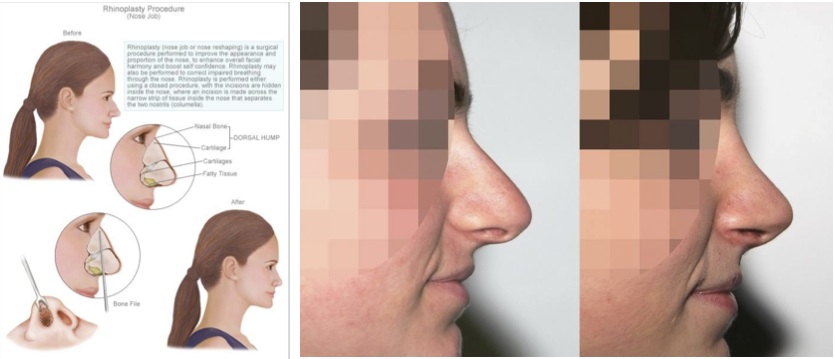Nose reshaping surgery (Rhinoplasty)
Nose correction is the oldest and mostly done plastic surgery. With a nose reshaping surgery, the nose can be made larger, smaller, or straighter. Moreover, the form of the nose tip and the nostrils can be changed.
Basic preconditions:
You are over 18 years old, in good physical and psychological condition and have a realistic idea.
You are not pregnant and not nursing your baby.
Preparations:
About 4 weeks before the surgery, you should reduce smoking. Moreover alcohol should be avoided.
About 2 weeks before the surgery you should not take anticoagulants (Aspirin, acetylsalicylic acid containing drugs).
For about 2 weeks before the surgery you should avoid sunbaths or solarium, particularly in the face. If you have short hair, you should grow it a bit longer, in order to cover the sutures in the period of recovery.
Not later than 3 weeks before the surgery the birth control pill must be discontinued.
For about 2 weeks before the surgery you should avoid sunbaths or solarium, particularly in the face. If you have short hair, you should grow it a bit longer, in order to cover the sutures in the period of recovery.
Not later than 3 weeks before the surgery the birth control pill must be discontinued.
Surgery preparations and examinations: For the surgery you need a blood count and an ECG. Your GP can provide both. Please bring the findings with you (it should not be older than two weeks).
If you are over 40 you need a complete blood count and an ECG for the correction of bone structure.
Length of the surgery:
Usually the correction of the bone structure takes 1-2 hours. The treatment is conducted during a stationary stay of 2 days in hospital. The correction of cartilage tissue takes usually 1-2 hours and is done as an outpatient procedure.
Course of action:
Before the surgery you will be informed during a detailed counselling talk on how the surgery is done, possible complications, risks, and alternatives. Maybe you want to write done your questions on the surgery. The nose reshaping surgery (bone structure) is conducted under general anaesthesia. The correction of the cartilage tissue (nose tip) can be done under regional anaesthesia. Before the anaesthesia you will be advised by an anaesthetist about the risks, complications and possible alternatives to a narcosis. The anaesthetist will be present during the surgery. A general anaesthesia means stress for the body. During narcoses risks or complications can occur, depending on previous diseases and your general state of health.
The small incisions are made inside the nose, thus visible scars at the outside can be avoided. Through these incisions bones and cartilages are separated from the mucosa and the skin. With the help of devices that have especially been invented for nose correction surgery superfluous cartilage tissue and bone can be removed.
Thus a long nose can be shortened and the nose tip can be reshaped. If the nose is crooked all defective positions of the cartilage and bones are corrected. After the treatment the mucosa and skin are fixed again with self-dissolving suture. Secretion is absorbed by a soft tamponing in the nasal duct. The tamponing also helps to stabilise the nose. Moreover the nose is supported by a special bandage or a splint.
Perception and possible complications:
After the surgery you will have visible swellings, haematoma, and some pain which usually easily subsides by taking the drugs you get in hospital. For some time the sensitivity of the nose, the mucosa, and the upper lip can be reduced. Moreover, in the first weeks after the surgery nasal breathing may be limited, as the mucosa is swollen.
Pressure marks from the supporting bandages usually heal without any difficulty. Particularly when an incision was made at the nose bridge there may be infections and problems in wound healing. This can lead to a shortening of the nose bridge. In this case another surgery would be necessary.
After a surgery there can occur blood clots in the main veins (thrombosis), these can be carried further and thus block a blood vessel (embolism). As prevention it can be considered to take anticoagulant drugs (i. e. injections of heparin), however these cause an increased bleeding tendency and in very rare cases grave dysfunctions of blood coagulation.
Even when the wound healing is normal, scars can initially become red or harden. After a while they will fade, they become inconspicuous. You will be informed on further risks and possible side-effects in a comprehensive handout.
After the surgery:
Usually the tamponing can be removed one day after the surgery. The splint should normally be removed 10 days after the treatment. You have a follow-up examination before you go home. During the first few days after the surgery you should avoid any physical labour. You should avoid sports for 3-4 weeks. Usually you can take showers again as soon as the wounds are completely closed.


